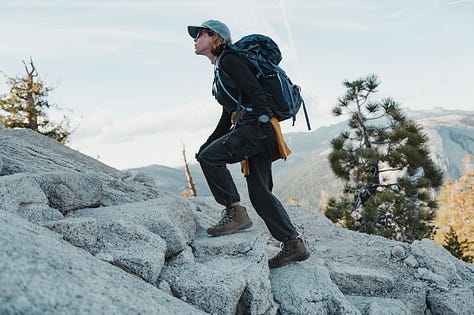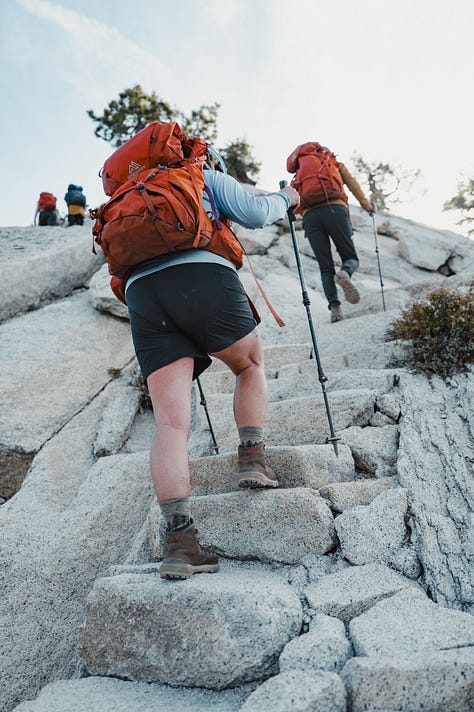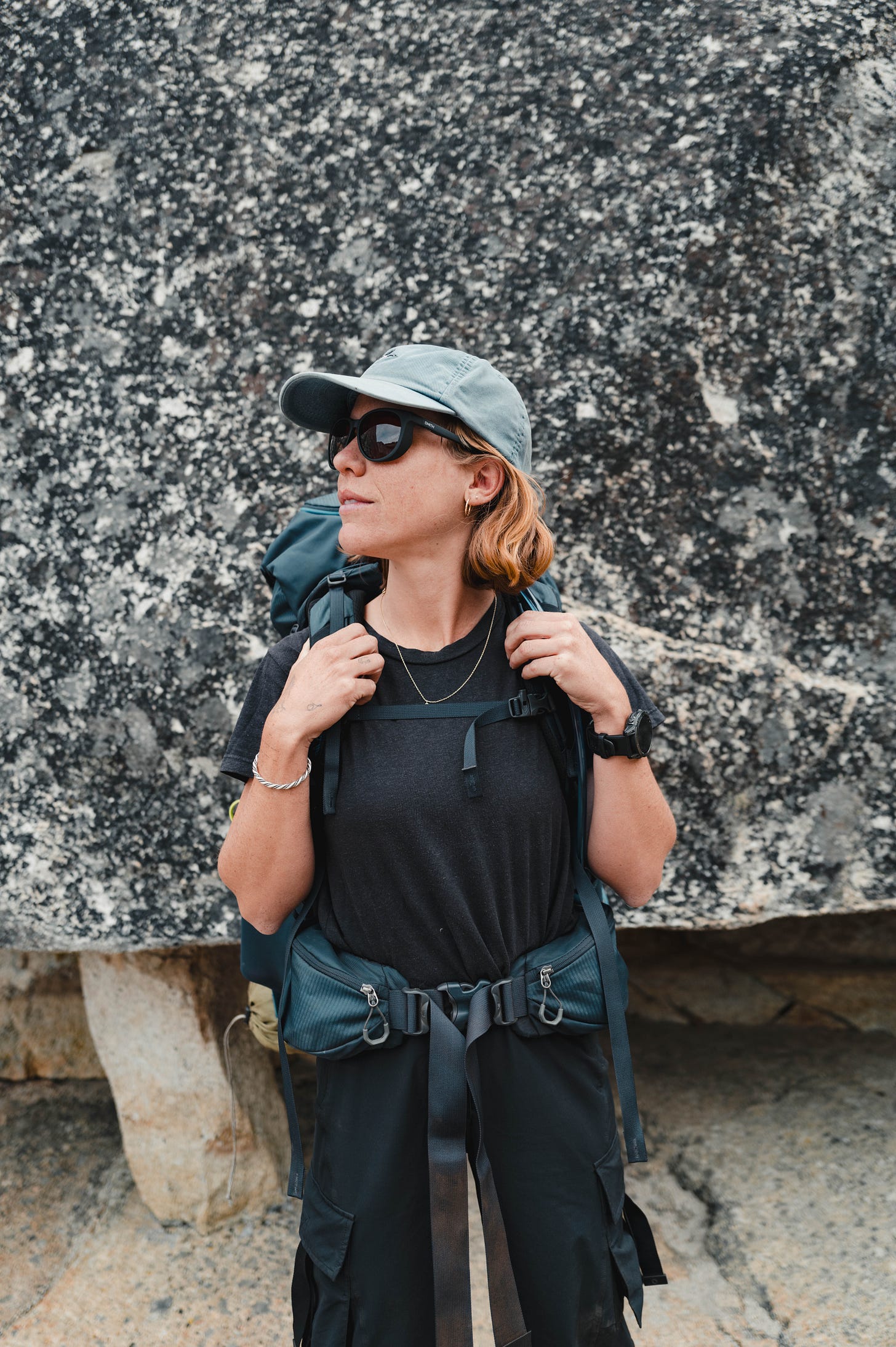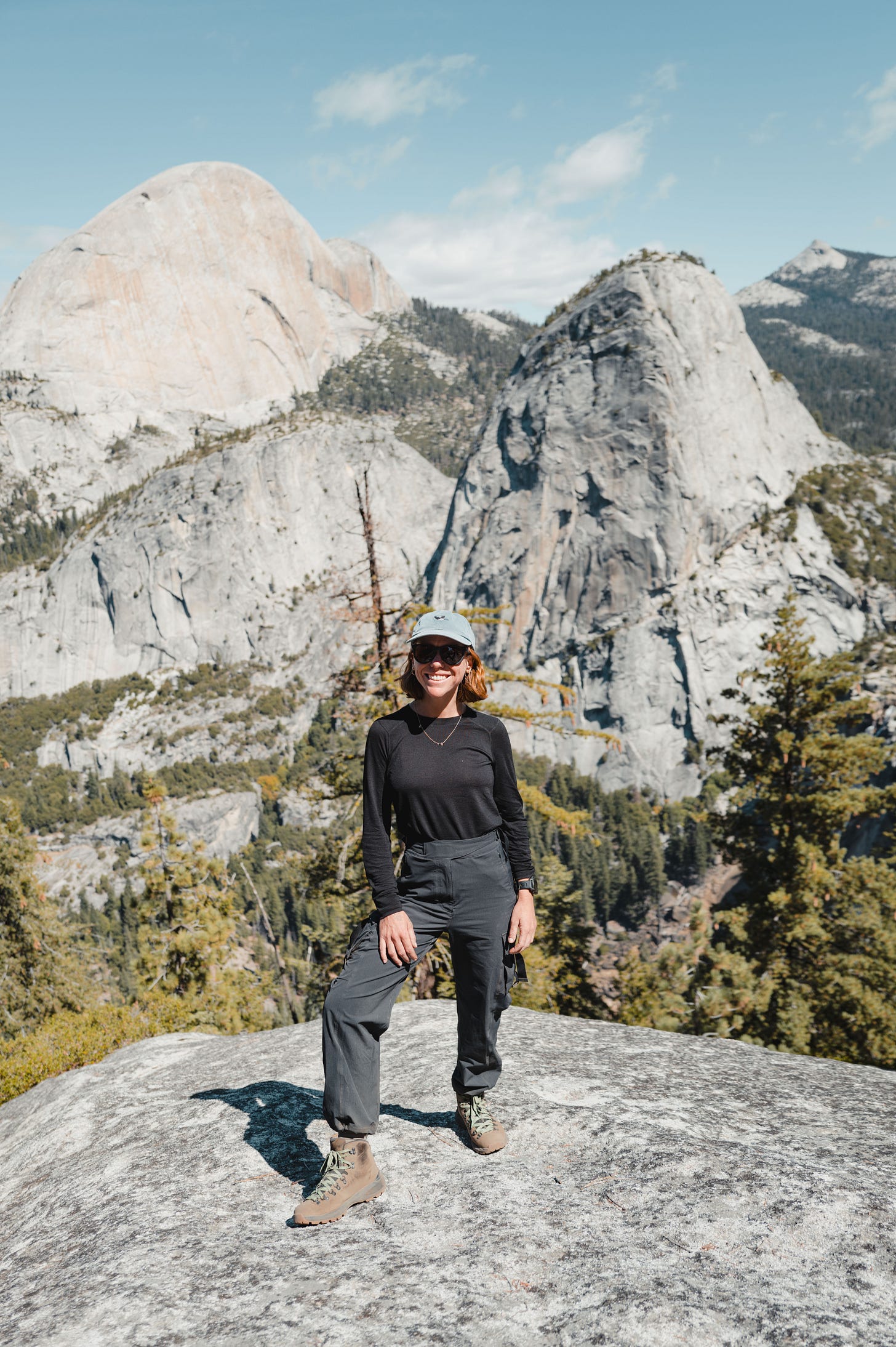I Came Within 400 Feet of Summiting Half Dome… And Didn’t Make It
A story of how trusting my body and resisting the fear of missing out led to one of the best decisions of my life.
I stood before the endless wall of rock, my head spinning, back of my neck tingling, stomach churning and feet rooted firmly to the spot.

I’d been invited on this backpacking trip with Danner in July 2024, two months prior, with the goal of testing the brand’s Mountain Evo 600 boot. I’d spent the last two and a half days climbing my way through the Yosemite Valley for this. I’d been staring at this mass of rock for days, minutes and hours as I’d made my way from Glacier Point, over Nevada Falls, through Little Yosemite Valley and all the way to where I now stood, on top of Sub Dome. It was sunset, the wind was starting to howl, and I was perched roughly 8,400 feet in the air. I’d already climbed further than 99.5 percent of the visitors that make their way to Yosemite National Park each year, according to our guides. I was within 400 feet of finishing the entire climb and summiting Half Dome, and I knew in the pit of my stomach and the back of my mind that I was not going to succeed.
This is my story of failing to reach the top of Half Dome — and why I don’t consider it a failure at all.
There’s really no way to describe the feeling of standing on top of Sub Dome. I took pictures and videos in that moment, but looking at those now flattens and warps that pivotal experience that shook me to my core.
If you haven’t been, the top of Sub Dome sits around 400 feet below the top of Half Dome, which towers 8,800 feet above sea level. The top of Sub Dome offers an almost 360-degree view of the surrounding Yosemite Valley. From where I stood, I could see North Dome, Cloud’s Rest, Starr King and the back of Liberty Cap. I was able to look roughly 4,400 feet down into the Yosemite Valley, and simultaneously could see the ridge of the Eastern Sierra as it winds its way south. The clouds were on the same level as my field of vision. It takes hours to climb from the Little Yosemite Valley campground all the way to where I stood, now shaking and crying.
Climbing the final stretch of the summit to Half Dome is a matter of trusting in the 150-year old posts and cables that are anchored into the rock face, with wooden steps to rest on every 10-15 feet. Those cables have seen countless storms, thousands of feet stepping on the surface of the rock and multiple deaths.
Summiting Half Dome is no joke: there are multiple signs along the trail letting climbers know if they don’t take the experience seriously, and if they try to climb Half Dome with ANY kind of moisture on the rock, the possibility of slipping and falling to one’s death is high. People die in Yosemite National Park every year. The day my group left for our backpacking trip, I read an article sharing the news of a hiker’s death the day before. A young woman slipped and fell to her death trying to descend the summit of Half Dome a month and a half prior to our planned summit. The risks involved in climbing Half Dome are not zero.

That afternoon, after we had set up camp in Little Yosemite Valley, I’d made it up the two-and-a-half hour hike with an accompanying 2,000+ feet of elevation gain no problem. I thrive on solid ground and was excited, if not a little nervous, for what was to come. But when I got to the base of Sub Dome, and looked at the almost vertical set of stairs that cut switchbacks into the rock face, I started to lose my cool — inwardly, of course. I don’t like to let emotion show in groups, especially not when I think my fear could infect anyone else. I stopped chatting and started focusing on each steep step in front of me. I stopped looking at the view. Each passing step brought me further away from the safe haven of flatter ground, and each foot of elevation I gained brought the surreal and terrifying view into focus. This was not going to be pleasant.

I did not fully anticipate my negative reaction to heights. I’ve been skydiving, parasailing, ice climbing, downhill mountain biking, river rafting, backcountry skiing… and always been able to finish the task laid out before me. Not all of my adventures have been pleasant, and some have been downright misadventures, but I’d never backed down from a challenge before. Two of our group of six had packed harnesses and tethers in their packs at the very beginning of our trip, even though our young-but-experienced guides had assured us that we would not need them. They’d each boasted that the success rate of summiting Half Dome was 98 percent — and that reassurance, combined with the fact that I thought I’d conquered my fear of heights, led me to the egoic decision to leave a harness and tether out of my pack, claiming to myself that I didn’t want the extra weight. That proved to be a massive mistake.



About three-quarters of the way up Sub Dome, I looked away from the rock steps in front of me to take in the view and see how I felt. Again, bad idea. My head swam as I took in the sheer vertical drop that surrounded every part of me except for face of rock I’d been focusing on, twelve inches in front of me. I felt panic, fear and guilt rise up in my gut like a burning wave. One of our two guides saw my face and stopped with me, asking how I was feeling. I couldn’t open my mouth, because I knew I’d start crying. He asked me multiple questions; I don’t remember the first two, but when he asked me if I was feeling scared, all I could do was raise a finger in agreement. The tears that had been welling up behind my eyes slid down my cheeks. I was burning from the inside out and wanted to crawl into a cave. I wasn’t supposed to react this way. I was supposed to be strong.

My guide stayed with me until I was ready to continue climbing Sub Dome, offering me quiet encouragement. Two of the women in my group also hung back and offered kind words, none of which I remember now, but I do remember the feeling of being supported. I hated that feeling in the moment, but I appreciate it now.
I was hoping when I reached the top of Sub Dome that I’d be able to calm my breathing, calm my mind and finish the climb — but the view from the top of Sub Dome was so demanding, so overwhelming and so terrifying I knew there was no way I was going to make it up Half Dome. I watched my group prepare for the last ascent, and jealously watched the other two women who had been smart and humble enough to pack harnesses slip them on and prepare for their climb.

My guide told me that in each group they guide, around twenty percent can’t make the final summit up Half Dome. That like me, the instinct of fear and self preservation is so strong that they’re physically not able to force themselves up. (This was at odds with the 98 percent success rate he and our other guide had mentioned at the beginning of our trip, but I wasn’t thinking straight enough to comment on that discrepancy.)
He offered condolence in the form of reminding me that we adventure in the outdoors to enjoy ourselves — and if we’re not enjoying ourselves, we shouldn’t push past our own limits for the sake of some bucket list item. I needed to hear that. I touched the cables one time to see if I could try it — but the pulse of fear was so strong when I touched that braided metal that I backed away immediately. I hung back and watched my group start the ascent, and then sat down on the wide expanse of rock that is Sub Dome to wait. That’s when I finally cried — all alone and (almost) on top of the world. And that’s also when I finally relaxed enough to take in the view — and enjoy myself.
I mentioned the idea of succeeding earlier in this story — and feel I should offer a correction, now that we’ve come this far together. In many cases, summiting Half Dome would have been the measure of success in this story — but for me, it would be the definition of failure. I don’t spend my time in the outdoors with a mental checklist of everything I want to conquer. Yes, I have goals and aspirations, and I certainly don’t like backing down… but at my core, I spend my time in the outdoors, and I work in the outdoor industry, because I love being outside. That’s it. Everything else is gravy.

In this instance, I wanted to finish the climb, but summiting Half Dome would have been a failure. A failure to listen to my body. A failure to listen to my instincts. A failure to follow my own compass, and rather use someone else’s barometer of success as a way to measure my worth. I didn’t make the climb to Sub Dome because I had the internal demand to finish Half Dome. It would have been incredible, but there was something in me that just knew it wasn’t going to happen this time. In fact, the entire backpacking trip there, I had a gut feeling I wasn’t going to make it up — a feeling that I was okay with the entire time, and still am. The moment I broke down on Sub Dome was incredibly uncomfortable for me — especially have others witness my struggle. But it was also liberating, and freeing, and safe, and as I reflect on the experience, those feelings are more important to me than the last 400 feet.

In my mind, the outdoors is not meant to be conquered. Maybe it would have felt “better” sharing this experience if the headline of this story had been about how I’d made it to the very top of Half Dome, but I don’t know… I still feel good right now telling the truth of my experience, and following my heart in that moment. I feel even better being alive, rather than splattered on a rock with only my ego intact. Maybe if I had forced myself to climb those last 400 feet, I would have achieved the summit. But I’m sure in the process, I would have irreparably broken my trust in myself. If I want to climb Half Dome again — with a harness and tether, mind you — then I’ll do it. The rock will be there for me, whenever I want it. But for now, I’m happier to be sitting here, trusting myself to turn away from a bright and shiny goal — and turn toward discovering more of who I actually am.





This!!! A massive success in the art of trusting yourself.